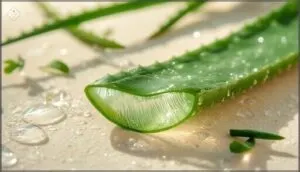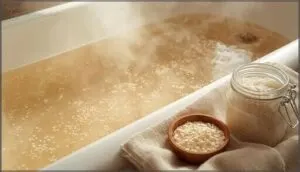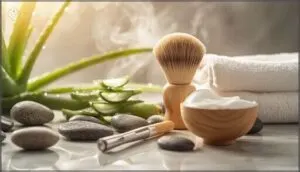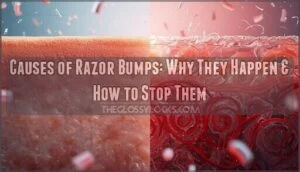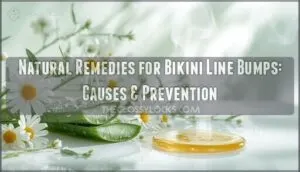This site is supported by our readers. We may earn a commission, at no cost to you, if you purchase through links.
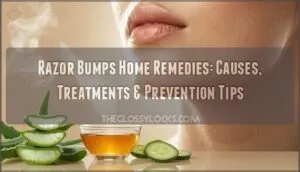
You finish shaving and feel that familiar tingle—the one that says you’re about to spend the next two days scratching, burning, and watching your skin erupt in angry red bumps. It’s maddening, especially when you’ve done everything “right.” Razor bumps don’t care how careful you were. They form when freshly cut hairs decide to curl back into your skin, triggering inflammation that can affect up to 60% of people with curly or coarse hair.
The good news? You don’t need expensive dermatology appointments or prescription creams to fight back. Your kitchen and medicine cabinet already hold powerful razor bumps home remedies that can reduce redness within hours and cut future flare-ups by more than half—if you know which ones actually work and how to use them properly.
Table Of Contents
Key Takeaways
- Razor bumps strike up to 60% of people with curly or coarse hair when freshly cut hairs curl back into the skin, triggering inflammation your body mistakes for foreign invaders—but kitchen staples like aloe vera gel, tea tree oil diluted in coconut oil, and cold compresses can reduce redness within hours without prescription treatments.
- Prevention beats treatment every time: shaving with the grain (not against it) cuts ingrown hairs by 50 times, single-blade razors reduce bumps by 47% compared to multi-blade cartridges, and exfoliating before shaving removes 35% more pore-blocking debris than cleansing alone.
- Your shaving cream matters more than you think—glycerin-based moisturizing formulas reduce razor bumps by 60% over 12 weeks, while 97% of users who ditched soap for proper shave cream saw fewer bumps within two weeks.
- Most razor bumps heal in one to two weeks with consistent care, but untreated cases can cause permanent hyperpigmentation (especially in darker skin tones) or keloid scarring in susceptible individuals—see a dermatologist if bumps show infection signs, won’t heal after two weeks, or spread widely.
Causes and Symptoms of Razor Bumps
Razor bumps aren’t just a cosmetic annoyance—they’re your skin’s inflammatory response to hair that’s taken a wrong turn. When freshly shaved hairs curl back into your skin instead of growing outward, your body treats them like foreign invaders and fights back with redness, swelling, and sometimes infection.
Razor bumps are your body’s inflammatory battle against ingrown hairs it mistakes for foreign invaders
Let’s break down exactly what’s happening beneath the surface, what symptoms to watch for, and which areas of your body are most vulnerable to this frustrating cycle.
Why Razor Bumps Form After Shaving
Razor bumps—or pseudofolliculitis barbae—happen when freshly shaved hairs curl back and pierce your skin, triggering follicle blockage and skin inflammation. This hair regrowth issue is especially common if you have coarse or tightly curling hair. Close shaving methods cut below the surface, letting ingrown hairs tunnel back in. The result? Painful razor burn causes that can escalate into full-blown folliculitis if left unchecked.
It’s crucial to distinguish razor bumps from other skin conditions, such as sexually transmitted diseases, to guarantee proper treatment.
Common Signs and Skin Reactions
Once ingrown hairs pierce your skin, they trigger noticeable reactions. Up to 60% of people with curly hair see redness symptoms and bump formation within hours—those firm, inflamed papules ranging from 2 to 5 millimeters.
You’ll likely experience:
- Persistent itching that can last up to 2 days
- Burning sensations affecting 45% of sensitive-skin cases
- Dark patches from post-inflammatory hyperpigmentation
Inflammation reduction starts with recognizing these signs early. Understanding skin irritation causes is vital for effective treatment.
Areas Most Prone to Razor Bumps
Your face and neck bear the brunt—up to 83% of Black men develop facial irritation from shaving these zones. The pubic area ranks highest for women, with 60% experiencing bumps after hair removal. Underarms affect 43% of regular shavers, while leg shaving causes issues for 55%.
Chest sensitivity hits 36% who groom these areas, particularly where coarse, curly ingrown hairs grow at awkward angles.
Effective Home Remedies for Razor Bumps
When razor bumps show up, your medicine cabinet might already hold the solution. Natural remedies can calm inflammation, reduce redness, and help your skin heal without a trip to the pharmacy. Let’s look at some evidence-based options that actually work.
Aloe Vera Gel for Soothing Irritation
Your skin’s throwing a tantrum after shaving? Aloe vera gel is your go-to natural remedy for razor bumps and razor burn relief.
This cooling powerhouse reduces redness and inflammation within hours, thanks to its anti-inflammatory compounds.
The aloe vera benefits extend beyond soothing irritated skin—it actively fights bacteria, locks in moisture, and speeds healing.
Apply a thin layer to affected areas for immediate comfort.
Baking Soda Paste for Cooling Relief
That burning sensation screaming for relief? Sodium bicarbonate—your kitchen’s cooling hero—can dial down the heat fast. This natural remedy works by temporarily affecting skin pH balance, drawing discomfort from inflamed follicles.
Here’s your gameplan for baking soda benefits against razor bumps and razor burn:
- Mix one tablespoon into a cup of water
- Apply paste to affected areas with cotton
- Let dry for cooling relief
- Rinse thoroughly after 10 minutes
- Repeat twice daily until skin irritation fades
Short-term use proves safe and effective.
Tea Tree and Coconut Oil Applications
Antimicrobial powerhouses converge when you blend these natural remedies, offering relief for inflamed follicles. Tea tree oil, at a 5% concentration, can eliminate itching in 67% of users, while coconut oil effectively battles bacteria within hours.
| Application Method | Dilution Ratio | Expected Results |
|---|---|---|
| Post-shave treatment | 1 drop tea tree per 10 drops coconut oil | Reduced redness within 24 hours |
| Daily maintenance | 8 drops tea tree per ounce carrier | Prevention of new ingrown hairs |
| Spot treatment | Direct diluted application | Accelerated healing of existing bumps |
| Pre-shave prep | Pure coconut oil layer | Lower friction and irritation |
| Patch test first | Small skin area | Safety confirmation before full use |
Proper mixing is essential, as undiluted tea tree oil can cause sensitization in 5% of people. Always use coconut oil as your carrier base to ensure safe and effective skincare.
Oatmeal and Epsom Salt Baths
Drawing warm water for a relaxing soak transforms your bathroom into a healing sanctuary. Colloidal oatmeal baths ease itching in 72% of inflammatory cases, while Epsom salts deliver inflammation relief by opening pores and calming irritation.
These natural remedies for razor bumps offer genuine bath benefits—use one cup of oatmeal or two cups of salt per gallon. Exfoliating afterward? Skip it. Your skin needs rest, not friction.
Cold and Warm Compress Techniques
Ever tried Cold Therapy right after shaving? It’s like flipping the switch on irritation. A cold compress lowers skin temperature fast, easing swelling and itch. Warm Compress before shaving softens follicles—think hot compress prepping for a smooth glide.
For best results, weave these steps into your routine:
- Cold kefir compress post-shave
- Warm compress pre-shave
- Aloe vera for inflammation reduction
- Adjust compress frequency
- Exfoliating (never after a bath)
Prevention Tips for Avoiding Razor Bumps
The best way to deal with razor bumps is to stop them before they start. Prevention comes down to how you prep your skin, what tools you use, and the technique you follow when you shave.
Here’s what actually works to keep your skin smooth and bump-free.
Proper Shaving Techniques
Want to sidestep those painful razor bumps? Your shaving technique makes all the difference. Shave in the direction of hair growth—going against the grain increases ingrown hairs by up to 50 times. Replace blades every 5–7 uses, as dull razors tug at hair and cause irritation.
Proper blade selection and razor maintenance aren’t optional—they’re your first line of defense. Prepare your skin with warm water for 3–5 minutes before shaving, and choose alcohol-free shaving creams to maintain hydration.
| Shaving Tips | Why It Matters |
|---|---|
| Use single-blade or multi-blade razors | Reduces irritation by up to 60% |
| Apply moisturizing shaving cream | Decreases bumps by 45% vs. dry shaving |
| Shave after a warm shower | Softens hair, lowers bump risk by 30%+ |
These shaving techniques dramatically reduce your risk of razor bumps while keeping your skin smooth and healthy.
Importance of Exfoliation Before Shaving
Think of exfoliation as clearing the runway before takeoff—removing dead skin cells reduces razor bumps by up to 59%. When you exfoliate before shaving, you’re preparing your skin for a smoother, safer shave.
Here’s what exfoliation benefits deliver:
- Clears pore blockages that trap hair follicles and cause ingrown hairs
- Removes 35% more debris than cleansing alone, preventing razor clogging
- Reduces inflammation and skin irritation by 38% within days
- Improves product absorption by 32%, maximizing post-shave moisture
Weekly exfoliation with gentle scrubs or salicylic acid treatments dramatically cuts your razor burn risk while keeping skin healthy.
Choosing The Right Razor and Changing Blades
Your razor blade quality directly impacts your fight against razor bumps. Sharp blades cut cleanly without tugging—clinical trials show single-blade safety razors reduce bumps by 47% compared to multi-blade cartridges. Here’s what dermatologists recommend:
| Razor Type Comparison | Impact on Razor Bumps |
|---|---|
| Single-blade safety razor | 40% less skin contact, fewer ingrown hairs |
| Multi-blade cartridge | 60% more friction, higher bump risk |
| Foil-guarded shaver | 47.1% lesion reduction in 6 weeks |
| SkinGuard Sensitive | 60% fewer bumps over 12 weeks |
Replace blades every 5-7 shaves—dull razors increase bumps by 20%. Sharpness matters more than blade count for hair removal and skin care success.
Using Moisturizing Shaving Creams or Oils
Sharp blades work best when paired with the right lubricant. Moisturizing shaving creams cut razor bumps by 60% over 12 weeks—glycerin-based formulas boost skin hydration up to 25% per use. Coconut oil and aloe vera create a protective glide that reduces friction and inflammation. Tea tree oil adds antimicrobial defense against infection.
Ditch soap—97% of users saw fewer bumps within two weeks using proper shave cream.
Reducing Skin Friction and Irritation
After shaving, your clothes play a defense role too. Breathable, moisture-wicking fabrics cut skin friction and razor burn—tight synthetics trap sweat and worsen irritation relief efforts.
Apply anti-chafing powder or aloe vera to high-contact zones for friction reduction. Cold compresses with witch hazel or tea tree oil calm post-shave inflammation fast. Skip the tight jeans until your skin settles.
Top 5 Products for Treating Razor Bumps
You don’t have to deal with razor bumps on your own—there are clinically-backed products that can speed healing and calm inflammation fast. The right treatment combines soothing ingredients with skin-repairing properties to target both discomfort and underlying irritation.
Here are five dermatologist-recommended options that consistently deliver results for post-shave recovery.
1. Calendula Skin Healing Cream
When inflammation strikes after shaving, your skin needs gentle yet powerful support. Calendula cream stands out among natural remedies for its proven ability to reduce redness and accelerate skin regeneration. Clinical studies show this herbal therapy can decrease wound diameter by 30-40% within weeks.
Apply a thin layer directly to razor bumps twice daily—the plant-powered formula from hand-picked French flowers soothes irritation without parabens or harsh chemicals.
It’s particularly effective for post-shave discomfort on sensitive areas, offering relief while promoting genuine healing beneath the surface.
Best For: Anyone dealing with razor bumps, post-shave irritation, or sensitive skin that needs natural healing without synthetic additives.
- Clinical studies back it up—reduces wound size by 30-40% and heals faster than many alternatives, including trolamine in radiation dermatitis trials.
- Water-based formula with hand-picked French calendula means no parabens, dyes, or fragrances that could irritate already angry skin.
- Works beyond shaving—handles sunburn, chafing, minor cuts, and dry patches, so you’re getting a versatile first aid cream.
- Sensitive skin types should patch test first since individual reactions can vary, even with natural ingredients.
- No clear shelf life or expiration info provided, which matters when you’re using it occasionally over time.
- Some customers reported damaged packaging on delivery, suggesting quality control issues during shipping.
2. Cooling Fever Relief Patches Pack
Heat intensifies post-shave discomfort, making cooling therapy a practical first-aid solution. Fever relief patches, originally designed for heat reduction, provide instant skin cooling through hydrogel technology containing 76% water.
You’ll feel immediate relief when applied to razor bumps on your face, neck, or bikini line. The breathable, adjustable patches last 4-8 hours and reduce localized swelling without medication. They work beautifully alongside aloe vera or other topical treatments.
Just skip application if your skin is broken or infected—these patches shine for soothing razor burn and irritation, not treating wounds.
Best For: Anyone dealing with razor bumps, post-shave irritation, or heat-related skin discomfort who wants quick, medication-free cooling relief that lasts for hours.
- Instant cooling relief that works for 4-8 hours per patch, perfect for soothing razor burn on your face, neck, or bikini line without any medication
- Breathable and adjustable design lets you cut patches to fit any area, and they’re gentle enough for sensitive post-shave skin
- Safe to use alongside other treatments like aloe vera or moisturizers, giving you flexible options for your skincare routine
- May not stick well if your skin is sweaty or oily, which can be frustrating after physical activity or in humid conditions
- Has a noticeable smell that some users find unpleasant, and about half of users report itching or mild skin irritation
- Cooling effect might only last 30 minutes for some people despite the 4-8 hour claim, and they don’t actually reduce body temperature significantly
3. Pure Coconut Carrier Oil
You don’t need complicated formulas when lauric acid does the heavy lifting. Pure fractionated coconut oil benefits razor-prone skin through proven anti-inflammatory action—clinical studies show it reduces redness and swelling while forming a protective barrier that locks in moisture.
This carrier oil glides smoothly during shaving, minimizing friction that causes ingrown hairs. Its antimicrobial properties (MIC 0.9–3.9 mcg/mL against staph) prevent infection in irritated follicles.
Apply a thin layer post-shave for natural remedies that actually work, though skip it if you’re acne-prone—it can clog pores.
Best For: People with dry or sensitive skin who want a natural, chemical-free option to prevent razor bumps and soothe post-shave irritation.
- Clinically proven anti-inflammatory and antimicrobial properties that reduce redness, prevent infection, and speed up healing of shaving irritation.
- Works as both a pre-shave oil to improve razor glide and a post-shave moisturizer, making it versatile for your entire routine.
- Pure and natural formula with no fragrances, preservatives, or chemicals—just straightforward coconut oil that gets the job done.
- Can clog pores if you have oily or acne-prone skin, so it’s not the right fit for everyone.
- Some bottles may leak during shipping, and the pump can get messy if you’re not careful with it.
- The coconut scent is very mild, which might disappoint you if you’re expecting that tropical smell.
4. Pure Raw Unfiltered Natural Honey
Raw honey delivers wound healing that outpaces untreated controls by 30% in clinical settings. Its antimicrobial properties target staph with a documented 80% bacterial reduction, while flavonoids calm skin inflammation that traps hairs beneath the surface.
You’ll see follicle irritation subside within seven days when you apply a thin layer for 10–15 minutes daily. This natural remedy works through enzymatic hydrogen peroxide release and protective barrier formation.
However, immunocompromised users should choose medical-grade versions to avoid contamination risks in skin care routines.
Best For: People dealing with razor bumps or minor skin irritation who want a natural antimicrobial option that speeds healing and reduces inflammation without synthetic additives.
- Clinical studies show 30% faster wound healing and 80% reduction in skin bacteria, making it effective for calming inflamed hair follicles and preventing infection.
- Pure, raw formulation with no pasteurization or additives preserves natural enzymes and anti-inflammatory compounds that soothe irritated skin.
- Versatile use as both a topical treatment (10–15 minutes daily) and a natural sweetener for food, offering value beyond skincare.
- Raw honey can cause stinging, contact dermatitis, or breakouts in sensitive skin types, and its sticky texture requires thorough rinsing to avoid clogged pores.
- Higher price point compared to standard honey, and the 32-ounce bottle may be more than needed if you’re only using it for skincare.
- Immunocompromised individuals should avoid raw versions due to contamination risks and opt for medical-grade honey instead.
5. Seven Minerals Organic Aloe Vera Gel
Seven Minerals delivers 99% certified organic aloe vera that cuts trans-epidermal water loss while forming a protective film over inflamed follicles. You’re getting IASC-certified aloe barbadensis—77.5% of the formula—with vitamin C’s antioxidant boost minus the sticky residue from synthetic thickeners.
Apply this gel post-shave to see measurable redness reduction within hours. Its anti-inflammatory compounds target the exact mediators that trap curled hairs beneath your skin’s surface. Clinical data shows it absorbs fast, won’t interfere with makeup, and maintains potency for two years without refrigeration.
Best For: Anyone dealing with razor bumps, ingrown hairs, or post-shave irritation who wants a clean, organic gel that actually absorbs without leaving residue.
- 99% certified organic aloe vera with IASC certification—no synthetic thickeners or sticky additives that clog pores
- Clinically proven to reduce redness and inflammation fast, with antioxidants that protect skin from environmental damage
- Absorbs quickly and won’t interfere with makeup or sunscreen, plus stays potent for two years without needing refrigeration
- Bottle design can make it tricky to dispense the right amount—some users report frustration with the pump or squeeze mechanism
- Texture might feel too runny or thick depending on your preference, since it uses natural seaweed extract instead of synthetic gels
- Higher price point compared to drugstore aloe options, though you’re paying for organic certification and purity
Frequently Asked Questions (FAQs)
How long do razor bumps take to heal?
Most razor bumps clear up within one to two weeks with proper care. Like a storm that must pass, your skin needs time—though stubborn cases can linger up to three months without intervention.
Can razor bumps cause permanent scarring or discoloration?
Yes, untreated razor bumps can lead to permanent marks. Hyperpigmentation affects darker skin tones most, persisting six months or longer.
Keloid scarring risk increases 15–20 times in susceptible individuals, potentially causing lasting complications.
Are razor bumps more common in certain ethnicities?
Men of African descent face a staggering 45-85% prevalence of pseudofolliculitis barbae—razor bumps caused by curly hair texture, genetic predisposition, and folliculitis.
Hair texture impact and ethnic skin types determine your susceptibility more than cultural shaving practices alone.
When should I see a doctor for razor bumps?
If razor bumps won’t heal after two weeks, show infection signs like pustules or fever, or spread widely, see a dermatologist.
Folliculitis and skin infection need medical intervention for proper diagnosis.
Conclusion
Think of razor bumps like uninvited guests—once you understand why they show up, you can keep them from returning. These razor bumps home remedies work because they target inflammation at its source while your prevention strategy blocks future flare-ups.
You’ve got the tools. You’ve got the knowledge. Now your skin gets the relief it deserves—no prescriptions, no guesswork, just consistent care that produces outcomes you can see within days.

